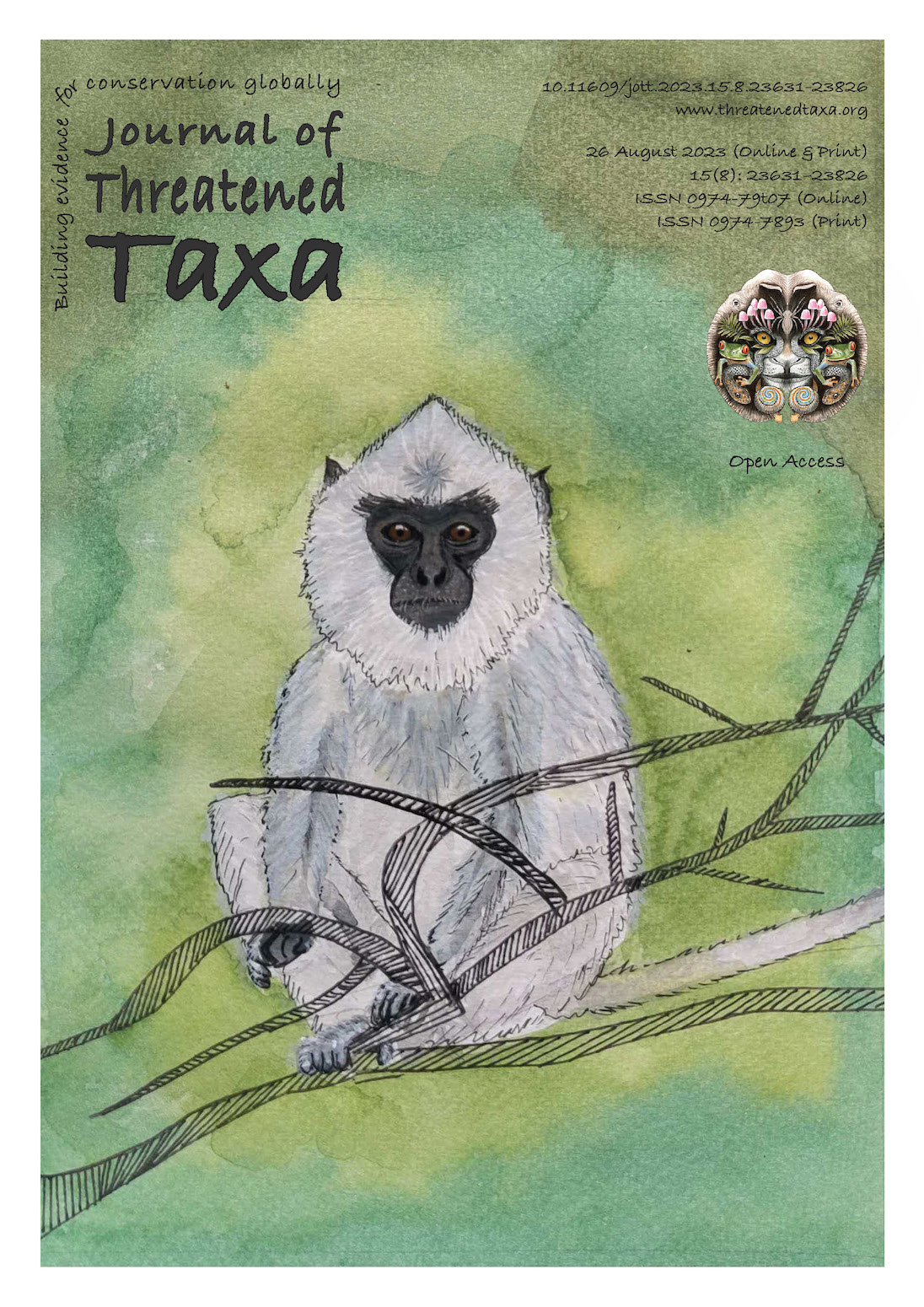Preference of Helopsaltes pleskei (Taczanowski, 1890) (Aves: Passeriformes: Locustellidae) on uninhabited islets (Chengdo, Jikgudo, and Heukgeomdo) in South Korea as breeding sites
Main Article Content
Abstract
This study was conducted to investigate the habitat and breeding status of the Pleske's Grasshopper Warbler (Locustella pleskei) inhabiting unmanned coastal islets (Cheongdo, Jikgudo and Heukgeomdo) on the Jeju Chuja Marine Provincial Park in South Korea. A total of 13 nesting sites were observed between April 2019 and April 2021. Six Camellia japonica (4 ea), Pinus thunbergii (1 ea) and Eurya emarginata (1 ea) nesting sites were found in the Cheongdo islet. Four C. japonica (2 ea), P. thunbergii (1 ea) and Elaeagnus macrophylla (1 ea) tree sites in Jikgudo islet were found, whereas only three C. japonica sites on the Heukgeomdo islet were observed. During the study period, 36 individuals were observed: 14 in Cheongdo, 10 in Jikgudo and 12 in the Heukgeomdo Islets. Most nesting sites were located in the bushy areas of the inner islets. Thus, birds tended to select nesting locations in response to predation and microclimates to increase reproductive rates and maximize offspring survival. This study highlights the importance of unmanned islands (islets) and the presence of bushy shrubs as important nesting and hiding sites for the ecologically vulnerable Pleske's Grasshopper Warbler.
Article Details

This work is licensed under a Creative Commons Attribution 4.0 International License.
Authors own the copyright to the articles published in JoTT. This is indicated explicitly in each publication. The authors grant permission to the publisher Wildlife Information Liaison Development (WILD) Society to publish the article in the Journal of Threatened Taxa. The authors recognize WILD as the original publisher, and to sell hard copies of the Journal and article to any buyer. JoTT is registered under the Creative Commons Attribution 4.0 International License (CC BY), which allows authors to retain copyright ownership. Under this license the authors allow anyone to download, cite, use the data, modify, reprint, copy and distribute provided the authors and source of publication are credited through appropriate citations (e.g., Son et al. (2016). Bats (Mammalia: Chiroptera) of the southeastern Truong Son Mountains, Quang Ngai Province, Vietnam. Journal of Threatened Taxa 8(7): 8953–8969. https://doi.org/10.11609/jott.2785.8.7.8953-8969). Users of the data do not require specific permission from the authors or the publisher.
References
Birdlife International (2001). Threatened Birds of Asia: the BirdLife International Red Data Book. Cambridge, UK, 2304 pp.
BirdLife International (2023). Species factsheet: Helopsaltes pleskei In: BirdLife International 2023 IUCN Red List for birds. Download on 19 August 2009. http://datazone.birdlife.org
Brazil, M. (2009). Birds of East Asia. China, Taiwan, Korea, Japan, Eastern Russia. Christopher Helm., London, 528 pp.
Choi, W.S., Y.W. Kim, J.C. Park, Y.S. Han & B.G. Chang (2017). The characteristics of the uninhabited island, the habitat for Styan’s Grasshopper Warbler, Locustella Pleskei. The Journal of Korean Island 29(1): 253–268.
Fujita, K., G. Fujita, T. Tomioka, Y. Yamamoto & H. Higuchi (2005). Estimated population sizes of Owston’s Varied Tits and Taczanowski’s Grasshopper Warblers, before and after the volcanic eruption of Miyake Island, the Izu Islands, Japan. Strix 23: 105–114.
Geijzendorffer, I.R., E.C. Regan, H.M. Pereira, L. Brotons, N. Brummitt, Y. Gavish, P. Haase, C.S. Martin, J.B. Minhoub, C. Secades, D.S. Schmeller, S. Stoll, F.T. Wetzel & M. Walters (2016). Bridging the gap between biodiversity data and policy reporting needs: an essential biodiversity variables perspective. Journal of Applied Ecology 53(5): 1341–1350. https://doi.org/10.1111/1365-2664.12417
Gómez-Serrano, M.Á. & P. López-López (2017). Deceiving predators: linking distraction behavior with nest survival in a ground-nesting bird. Behavioral Ecology (28)1: 260–269. https://doi.org/10.1093/beheco/arw157
Kearns, L.J. & A.D. Rodewald (2013). Within-season use of public and private information on predation risk in nest-site selection. Journal of Ornithology 154(1): 163–172. https://doi.org/10.1007/s10336-012-0882-7
Kim, E.M., H.J. Kim, C.Y. Choi, C.W. Kang, H.M Kang & C.R. Park (2009). Breeding site characteristics of Styan’s Grasshopper Warblers (Locustella pleskei) on Mara Islet, Jeju Province, Korea. Korean Journal of Environment and Ecology 23(6): 528–534.
Korea National Park Service (2019). Chuja Marine Provincial Park Natural Resources Survey in Jeju island. Gangwon-do Province: Korea National Park Service, 305 pp. [in Korean]
Lee, W.S., T.H. Ko & J.K. Park (2020). A Field Guide to the Birds of Korea. 2nd Edition. Seoul: LG evergreen foundation, 403 pp. [in Korean].
Nagata, H. (1993). The structure of a local population and dispersal pattern in the Styan’s Grasshopper Warbler, Locustella pleskei. Ecological Research 8: 1–9. https://doi.org/10.1007/BF02348601
National Institute of Biological Resources (NIBR) (2017). Endangered wildlife at a glance. NIBR, Incheon, 326-327 pp.
National Institute of Biological Resources (NIBR) (2019). Red data book of endangered birds in Korea. Incheon: National Institute of Biological Resources, 272 pp. [in Korean].
Montgomerie, R.D. & P.J. Weatherhead (1988). Risks and rewards of nest defence by parent birds. The Quarterly Review of Biology 63(2): 167–187.
Park, J.G. & J.H. Seo (2008). A Photographic Guide to the Birds of Korea. Shingu Media & Publishing, Seoul, 334 pp.
Polak, M. (2019). Nest concealment and nest defence by two passerines: effect of protective nesting association. Zoological Studies 58: e15. http://doi.org/10.6620/ZS.2019.58-15
Qiao, Y.L., Y. Liu, D.S. Guo, X.Q. Zeng & E. Zhang (2006). First Chinese breeding record of Pleske’s Warbler Locustella pleskei, from a small island off Qingdao, Shandong province. BirdingASIA 6: 81–82.
Takaki, Y., K. Eguchi & H. Nagata (2001). The growth bars on tail feathers in the male Styan’s Grasshopper Warbler may indicate quality. Journal of Avian Biology 32(4): 319–325. https://doi.org/10.1111/j.0908-8857.2001.320405.x
Wikum, D.A. & G.F. Shanholtzer (1978). Application of the Braun-Blanquet cover-abundance scale for vegetation analysis in land development studies. Environmental Management 2(4): 323–329.

